Women in Leadership: The Practical Path to Success

It’s no secret that women face unique challenges when it comes to pursuing leadership positions and achieving career success.
A 2022 study by Cranfield University found that less than 20% of executive directorships across FTSE 100 companies are held by women. And just 9 female CEOs are included in that group.
The stats still make for rather depressing reading and the road to change might feel like an overwhelmingly long one. But there are actions that both organisations and individuals can take today to make a tangible difference.
2023’s International Women’s Day encouraged us to embrace the concept of ‘equity’ – understanding that each person has different needs and accounting for this to achieve fairer outcomes.
This requires organisations to seek a deeper understanding of the needs of their employees. It involves listening, understanding, collaborating and communicating with team members on a regular basis.
And of course, individuals need the awareness, clarity and the capacity to communicate their needs too.
Through this, we can develop a fuller understanding of what it really takes to create greater levels of success and equity for all employees.
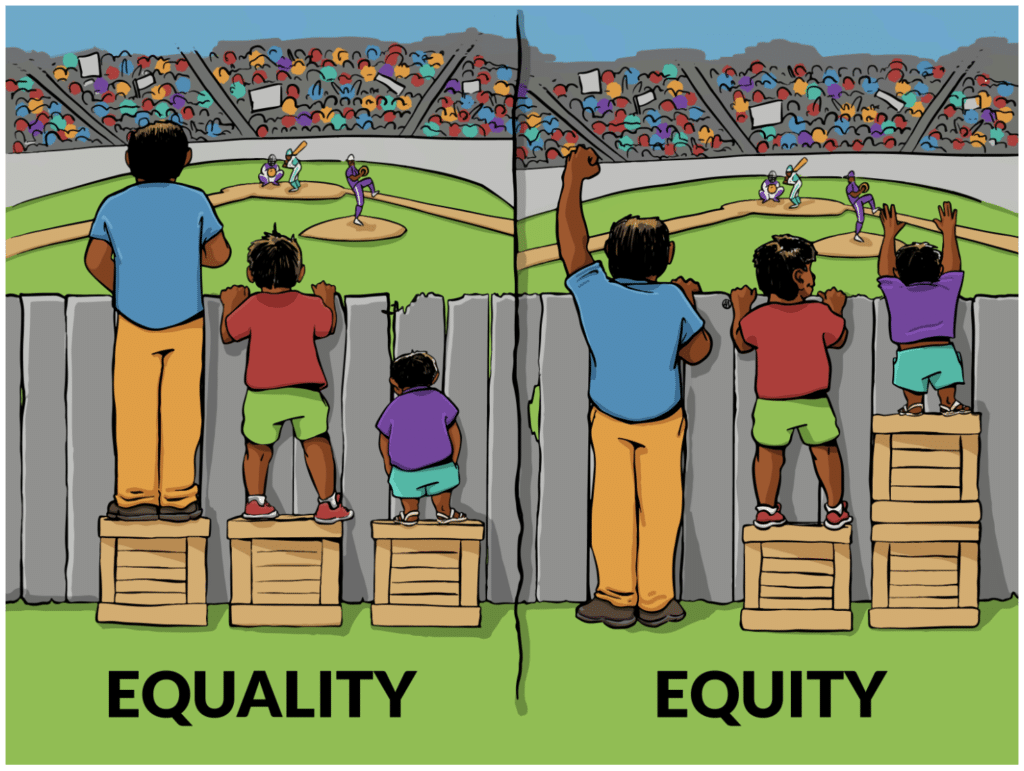
The dialogue around equity is certainly a valuable one – but it’s just one of many avenues through which a difference can be made.
There are many ways that ambitious women can take matters into their own hands,
tackling barriers and forging opportunities to advance into senior leadership positions.
We’ve scoured the data for the approaches that work – what can really make the difference.
In this blog, we’ll be exploring the strategies and best practices that women can use to advance in their careers. And we’ll also review policies and programs that employers can implement to support their progress.
From career planning and networking to mentorship and sponsorship, we’ll cover the key strategies that women can use to advance and succeed in leadership roles.
We’ll also explore the challenges and obstacles that women may face as they pursue their career goals, including bias and stereotyping, work-life balance, and the need for ongoing training and development.
Finally, we’ll look to the future, exploring the trends and strategies that can help support more women to succeed and thrive in leadership roles.
Whether you’re a woman looking to advance in your career or an employer looking to better support your female employees, this blog will provide insights and inspiration to help you achieve your goals.
So let’s get started, and celebrate the progress that women have made, while also looking forward to a future of greater diversity, inclusion, and gender equality in the workplace.
Don’t let your busy schedule hold you back from achieving your career goals!
Download our FREE Career Progression Toolkit for Women now to get a step-by-step guide based on research into the key drivers of women’s career success. With this toolkit, you’ll be able to identify your goals, create a plan to achieve them, and overcome any obstacles that come your way.
Table of Contents
Women in Leadership: The Current Landscape
Before we dive into the strategies and best practices that can help women succeed in leadership roles, it’s important to take a look at the current landscape of women in leadership positions.
Female representation in top-level positions:
- 96% of CEOs in the FTSE 350 are men, despite entry-level recruitment typically being close to 50:50. 1
- There has been some progress in the FTSE100 regarding the representation of women on the board. In 2022 it was 39.1%, up from 36.2% at the beginning of 2021. 2
- In 2021, women accounted for only 13.5% of top executive positions within the FTSE 100. 3
- In 2021, the proportion of women in senior management positions globally grew to 31%, the highest number ever recorded. Whilst there has been progress, it further highlights the need for more women leaders. 4
- The Fortune Global 500 reported an all-time high of 23 women CEOs in 2021, including six women of colour. 5
- Number of countries where the highest position of executive power was held by a woman has increased between 1960 – 2023. 6

Gender pay gap:
- According to the 2022 gender pay gap report, the mean gender pay gap is 5.45% and the median is 9.71%. In monetary terms, the mean hourly difference in ordinary pay is £1.44 compared to £1.48 in 2021 and the median hourly difference is £2.41 compared to £2.68 in 2021. 7
- In the US, the gender pay gap is significant: women earn $0.82 for every $1.00 earned by their male counterparts, with even greater disparities for women of colour (Black women $0.62, Native American women $0.57, and Latina women $0.54). 8
Women in Leadership Around the World:
- According to the UNESCO Women still account for almost two-thirds of all adults unable to read 9 and two-thirds of the 771 million adults without basic literacy skills. 10
- At 39%, Africa has the highest number of women leaders occupying senior management positions. Whilst gender parity is still far from being equal, almost every region measured reported their highest or equal highest percentage of women in senior management. This is a step in the right direction towards achieving greater gender equality in the workplace. 11

General Women In Leadership Stats:
- Female leaders are judged more harshly even when they outperform their male counterparts. 12
- Black women experience a double jeopardy following organisational failure. 13
- A third of women say their careers have been affected by sexual harassment. 14
- Two-thirds of women don’t think it is possible to return to work after having a baby in part-time senior positions. The percentage was higher in the tech industry, where three-quarters of women thought it was impossible. 15
The Importance of Women in Leadership: Why We Need More Female Leaders
Women have made significant strides in the workforce in recent decades, but there is still a long way to go when it comes to women’s representation in senior management roles. Despite the fact that women make up nearly half of the global workforce, they remain significantly underrepresented in higher positions. 16
This lack of gender diversity not only harms women but also has a negative impact on businesses and the economy as a whole.
Here’s why we need more women in leadership:
1. Diversity drives innovation
Studies have consistently demonstrated that teams with higher levels of gender diversity are more innovative and efficient. 17
This is because individuals from diverse backgrounds and experiences bring a fresh perspective and ideas to the table. By increasing the representation of women in leadership roles, we can leverage this diversity and drive greater innovation and growth in our teams.
Incorporating women’s voices and insights into decision-making processes can lead to more creative problem-solving and better outcomes for organisations. By embracing gender diversity and inclusivity in our workplaces, we can tap into the full potential of our teams and drive long-term success.
2. Women’s Representation Matters
Seeing female senior leaders in action can be incredibly empowering for other women, particularly those who are just starting out in their careers. When women can see themselves reflected in the leadership of their organisations, they are more likely to feel valued, supported, and motivated to succeed. 18
By promoting and celebrating women’s leadership, we can inspire and empower the next generation of female leaders.
This means providing opportunities for women to take on leadership roles, as well as highlighting their achievements and contributions. When we prioritise gender diversity and representation in leadership, we create a more inclusive and equitable workplace culture that benefits everyone.
3. Improved Financial Performance
Research has shown that companies with more gender diversity in leadership positions tend to perform better financially. 19 This is likely due to the unique skills and perspectives that female leaders bring to the table, which can result in better decision-making, risk management, and stakeholder engagement.
4. Enhanced Reputation
Organisations that prioritise gender diversity and women’s leadership are often viewed as progressive, innovative, and socially responsible. This can enhance their reputation among customers, investors, and other stakeholders, which can help attract and retain top talent and drive growth.
In short, the importance of women in leadership cannot be overstated. By promoting greater gender diversity in higher positions, we can drive innovative ideas, improve financial performance, promote greater equity and fairness in the workplace, and enhance a reputation as socially responsible and forward-thinking organisations.

Empowering Women: Guiding Principles for Organisations
Breaking down barriers for women in leadership is an ongoing challenge. Despite progress in recent decades, there are still issues, such as the gender wage gap and workplace biases that need to be addressed.
However, these barriers can be overcome! And employers can play a critical role in empowering women and supporting their career growth.
Later in this post, we will discuss in more detail the guiding principles that can help organisations overcome these barriers and empower women to achieve career success.
For now, here’s a quick overview…
1. Encouraging education and training
As women might not have had the opportunity to learn on-the-job, we need to ensure they have the skills and knowledge they need to succeed at leadership.
This could be giving employees a personal training and development allowance, setting up groups or lunch and learns specifically focused on women’s career development. These initiatives can help women gain the confidence and abilities they need to take on leadership roles and thrive in them.
2. Proving support and mentorship
In a world where a lot of career advancement occurs through networking and the ‘old boys club’, women can often feel excluded and need someone to help guide them, navigate their careers and overcome challenges. This involves finding mentors and sponsors who can give guidance and advice, and joining peer groups where women can connect and share experiences.
By joining such initiatives, women can gain a sense of community and a safe space to discuss challenges and opportunities. This can lead to increased empowerment and confidence in their career paths. With the support of mentors, sponsors, and peers, women can overcome obstacles and achieve their professional goals.
Female mentorship can be increased within organisations by developing formal mentoring programs, providing training for mentors and mentees, encouraging cross-gender mentoring, establishing mentorship circles, and rewarding mentors and mentees.
4. Challenging stereotypes and biases
Despite progress towards greater gender equality, many workplaces still hold biases and stereotypes that prevent women from reaching leadership positions. For instance, some people still believe that women are less capable than men, or that their contributions are less valuable.
These biases can significantly harm women’s careers!
To create better workplaces that support women’s goals, we need to challenge and fight against these stereotypes. One way to achieve this is by offering training and workshops that encourage people to speak up and challenge bias.
In addition, it’s crucial for leaders to model the right behaviours and call out bias when they see it. We need a culture where everyone feels comfortable speaking up and challenging bias, and where it’s clear that this behaviour is encouraged and supported.
By taking these steps, we can create more diverse and inclusive workplaces, where women have the same opportunities to succeed as men.
5. Advocating for change
Finally, it’s important for women to actively advocate for themselves and others when it comes to career progression. This means negotiating for higher salaries, pushing for more opportunities, and speaking up when bias or discrimination occurs. Women have the power to effect change in their workplaces by using their voices and leveraging their skills.
Creating more equitable and supportive work environments requires a commitment to gender equality across multiple fronts. A multifaceted approach involving education, support, advocacy, and challenging the status quo is necessary to empower women to succeed in their careers.
How can organisations support and promote change towards gender quality?
- Encouraging and funding women’s groups or committees within the organisation
- Ensuring that women have a seat at the table and given a voice when it comes to decision-making (including in the boardroom)
- Creating a culture of open communication and actively seek feedback from women to understand their needs and experiences in the workplace
By working together and committing to these efforts, we can help more women break through the barriers that hold them back and reach their full potential in the workplace. With dedication and perseverance, we can build more inclusive and diverse workplaces that enable women to thrive and succeed.

A Detailed Blueprint for Women’s Career Progression – Introducing Wichert & Steele’s 2013 Framework
The Career Progression Framework by Wichert & Steele 2013 is a widely recognised tool for helping women advance in their careers. This framework outlines a set of key principles and strategies for women to build their skills, increase their visibility, and advance to higher levels of leadership. It provides a practical blueprint for aspiring female leaders.
Here’s an overview of the key principles of the Career Progression Framework:
1. The individual: emphasises the importance of career planning, seeking opportunities, networking, and self-promotion for individual career advancement.
2. The immediate work environment: stresses the significance of supportive supervisors, mentors, and critical job assignments in advancing women’s careers.
3. The organisational context: focuses on creating a supportive work-life culture, implementing objective Human Resources processes, and addressing bias and stereotyping to ensure equity and diversity in career advancement opportunities.
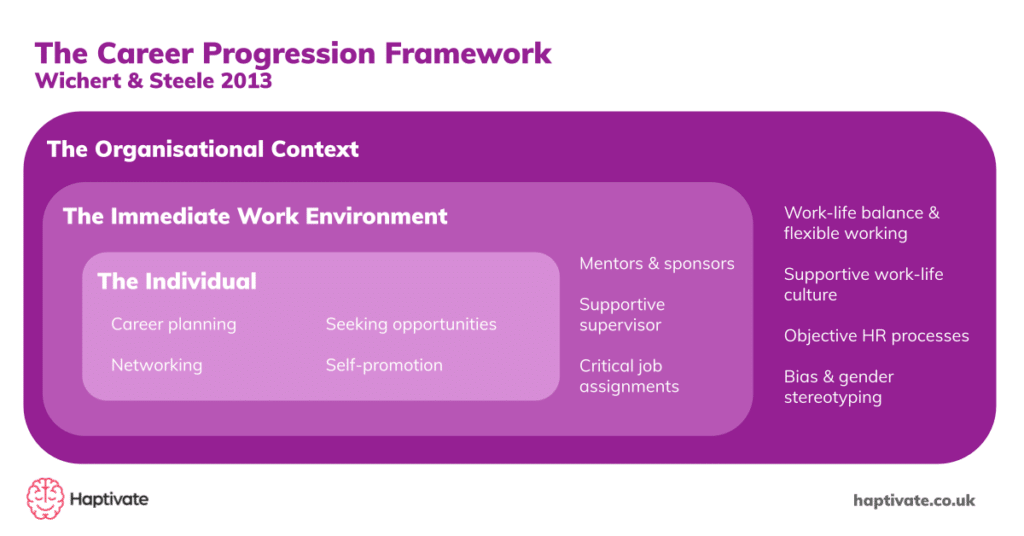
By following these key principles of the Career Progression Framework, women can develop the skills, network, and visibility they need to advance in their careers. This framework can also help women navigate the challenges and barriers that often arise on the path to leadership, and ultimately help create more diverse and equitable workplaces.
Let’s break each of the key principles down further…
The Individual
In this section, we’ll cover what women themselves can do to take control of their own careers and move ahead.
Career Planning for Women Leaders: Setting Goals and Mapping Out Your Path to Success
Planning your career is super important for making progress, but it’s also key to always remember that things don’t always go according to plan!
Rather than locking yourself into one fixed goal and ploughing ahead, it’s better to be more flexible and adaptable in your approach.
As a woman, it can be helpful to approach career planning as a fluid and ever-evolving process, where you’re open to exploring different paths and opportunities that may come your way. By embracing this more flexible mindset, you’ll be better equipped to navigate the twists and turns of your career journey and make the most of opportunities wherever they arise.
Here are some tips for setting goals and mapping out a path to success:
Identify Your Strengths and Passions
Knowing your own strengths and passions is the first step toward determining really meaningful career goals. Take a moment to reflect on your skills, interests, and values, and think about what really motivates and inspires you.
By getting in touch with your inner self, you can discover what makes you unique and what sets you apart from others. This self-awareness is crucial for setting career goals that align with what truly fulfils you. So, take some time to get to know yourself and what makes you tick!
If you’re in need of some guidance, the Values in Action (VIA) Survey of Character Strengths is a useful tool. This self-report questionnaire is easy to understand, with straightforward questions that you can answer yourself. With 240 items, it can give you a lot of insight into your character strengths and how you can use them to achieve your goals.
Explore Different Career Paths
Knowing what you enjoy and what you’re good at is the first step toward exploring career paths that match your interests and skills. You can do this by chatting with people who work in your dream job, scoping out different industries and leadership roles, and gaining experience through internships or volunteer gigs.
By exploring different career routes and gaining some hands-on experience, you’ll gain a better sense of what you like (and don’t like) and also what you’re good at. This will help you narrow down your options and find a career that truly excites you. So, don’t be afraid to put yourself out there and try new things – you never know where it might lead!
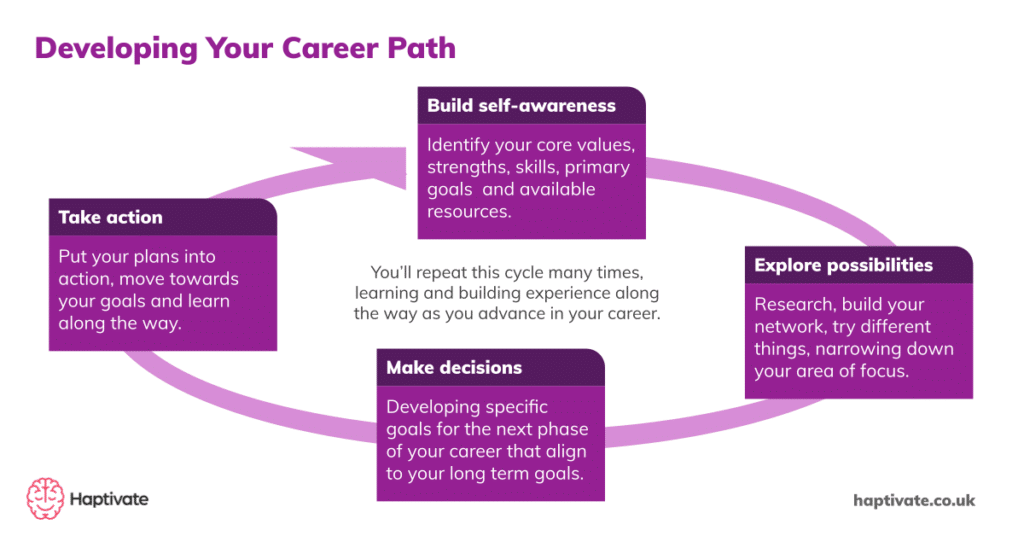
Set Achievable Goals
Don’t stress about having one big, scary career goal. Instead, focus on breaking down your aspirations into smaller, more manageable steps. This could mean learning a new skill, taking on an exciting new project, or going for a new role within your current company.
By setting smaller, achievable goals, you’ll gain momentum and feel more motivated to keep going. Plus, you’ll be building up your skills and experience along the way, making it easier to reach for the stars when the time comes.
A helpful framework for setting achievable goals is the SMART model, which stands for specific, measurable, achievable, relevant, and time-bound.
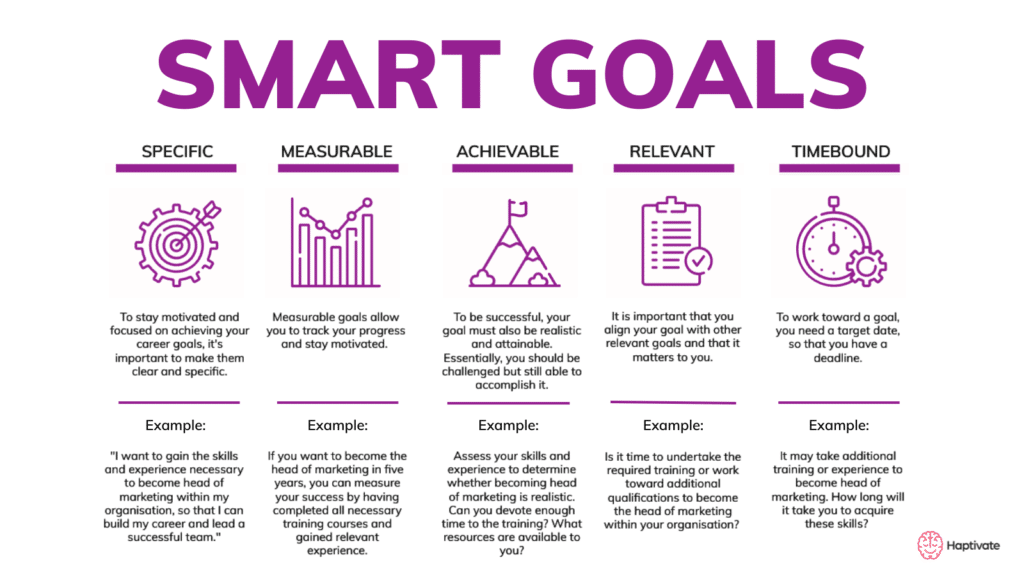
Stay Adaptable
When it comes to adapting to changes in your career, it can be helpful to come back to your values and passions. By staying true to what matters most to you, you can stay focused on your goals and find ways to regroup and reposition yourself, even in the face of shifting circumstances.
Additionally, it’s important to consider your spheres of influence and how they can help you navigate these changes. This means staying open to new opportunities and being ready to adapt your plan as things change.
Remember to stay flexible and go with the flow, rather than getting too attached to one fixed idea of what your career should look like. By doing so, you’ll be better equipped to handle whatever comes your way and make the most of every opportunity. So, stay cool and keep an eye out for new adventures – you never know where they might lead!
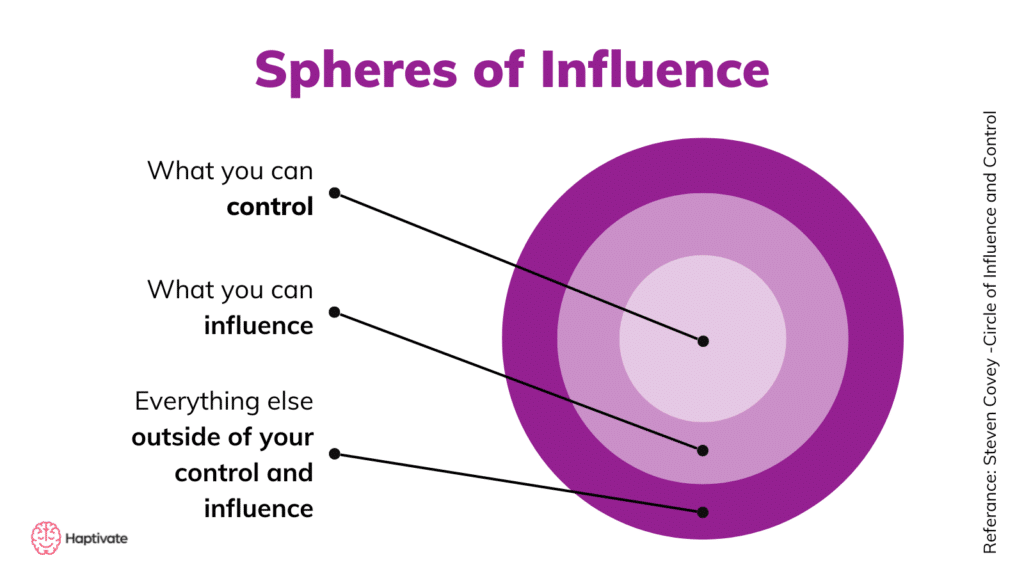
Seeking Opportunities: How to Find and Apply for Roles That Will Help You Progress
One of the keys to advancing in your career as a woman is seeking out opportunities that will help you build your skills and experience. But let’s be real – finding those opportunities is often easier said than done!
But don’t worry. Here’s some tips that will help you find your way to the top:
Set Clear Goals
We’ve already talked about setting goals, so we won’t go into too much detail here. But the first step to finding great opportunities is to set some clear career goals that match your skills, experience, and interests.
This means figuring out the kinds of jobs and challenges you want to tackle, and thinking about any new skills or experience you need to level up to make it happen.
To really stay focused on what you want, put pen to paper and write your goals down. It might seem cliche but, psychologist Gail Matthews found that people were 33% more likely to achieve their goals when they wrote them down instead of formulating them in their heads 20.
So, keep it real and keep those goals in sight!
Network Strategically
Building a strong network is key to finding opportunities that align with your career goals. This means seeking out mentors and sponsors who can offer guidance and support, as well as cultivating relationships with peers and colleagues who can offer new perspectives and opportunities.
The Harvard Business Review has a great resource to help you map out your network and unlock its potential.
It might feel a bit scary to put yourself out there and start building those relationships, but trust us – it’s worth it. By staying open and building a solid network, you’ll be better equipped to find those gigs that light you up and connect with people who can help you grow. So, get out there and start making those connections!
Be Proactive
When it comes to finding opportunities, it’s important to be proactive and take initiative. This may involve researching companies and industries you’re interested in, reaching out to recruiters or hiring managers, or seeking out referrals from your network. To make it happen, set aside some time every week to focus on these efforts.
It can feel a bit nerve-wracking to put yourself out there and take those bold moves, but it’s worth it to find a role that’s a great fit for you. So, don’t be shy – start reaching out and putting yourself in the mix.
Tailor Your Applications
When applying for leadership roles (or any role for that matter), it’s key to make ’em fit like a glove for the specific role and company. This means crafting a kick-ass CV and cover letter that showcases your top-notch skills and experience, and doing some digging on the company and job to make sure your app matches their needs and vibe.
Be Persistent
Keep plugging away! Apply for roles. Message recruiters and hiring managers (even if they ghost you).
It can be a bit of a slog to stay committed and focused on your goals, but it’s worth it to find that perfect role that’ll really boost your career. So, take a deep breath, keep your eyes on the prize, and don’t give up until you find the opportunity that’s right for you.
Ready to take your career to the next level?
The Women in Leadership Programme is designed to empower high-potential women with the strategies, problem-solving toolkit, and influence they need to excel in their roles. With our comprehensive training, you’ll gain the inspiration, tools, and support you need to be highly effective and happier in your work, setting you up for future success.
Networking for Women in Leadership: Building Connections and relationships that can advance your career
You know what they say – it’s all about who you know!
Networking is a huge part of moving up in any career, but it’s especially important for ladies looking to score those top leadership positions.
By building meaningful relationships with peers, mentors, and sponsors, women can score new opportunities, learn fresh skills and knowledge, and get their name out there in their field. So, hit up those virtual coffee chats, join those networking groups, and get your schmooze on! You never know where those connections might take you.
Here’s a few tips to help you get started:
- Start with your existing network: Think about your friends, family, former colleagues, and acquaintances who might be able to connect you with relevant people or opportunities.
- Attend events and conferences: Look for industry events, conferences, and workshops where you can meet like-minded professionals and learn about new developments and trends in your field.
- Join professional groups: Joining a professional association or industry group can be a great way to meet new people and stay up to date on industry news and events.
- Consider joining a networking group: There are plenty of groups out there specifically for women, like Women in Business, where you can connect with other like-minded women and learn from each other.
- Diversify your network: Diverse contacts in your network are crucial for creativity and problem-solving. Too much similarity limits access to new information, and without diverse perspectives, no one will question your reasoning or push you to expand your horizons. 21
- Be authentic and genuine: Just be yourself! Share your goals and interests and show genuine interest in other people’s careers and experiences. It’s not all about business, after all – it’s about building meaningful connections.
- Give back: Networking isn’t just about what you can gain from others – it’s also about what you can offer. By offering your own expertise and insights, and helping others in their careers, you can build stronger and more meaningful relationships with your network.

Shine like a star: tips for promoting yourself and your achievements
Self-promotion is an essential skill for advancing in any career, but it’s particularly important for aspiring women leaders.
Women often face unique challenges when it comes to self-promotion, including societal expectations around modesty and humility, as well as the risk of being perceived as aggressive or unlikeable. 22
But here’s the thing… promoting your achievements is crucial for your career success. Here are a few different ways you can do this:
- Share your achievements: Let people know about your accomplishments, whether it’s a successful project or a new skill you’ve developed. Don’t be afraid to brag a little!
- Be confident: Believe in your abilities and value as a professional. Speak up and express your opinions with conviction.
- Network: Build relationships with colleagues, mentors, and industry peers. Attend conferences and events, and use social media to connect with others in your field.
- Use social media: Share your work and accomplishments on social media platforms such as LinkedIn. Make sure your profiles are up to date and showcase your skills and experience.
- Seek feedback: Ask for feedback from colleagues and supervisors to help you identify areas where you excel and areas where you can improve
The Immediate Work Environment
In this section, we’ll explore how your work environment can impact your career growth.
Mentors and sponsors: finding supportive advisors who can help guide aspiring women leaders
If you’re a woman aiming to progress in your career, mentors and sponsors can make a world of difference. They can offer guidance, support, and open up new opportunities for you.
Here are some tips to help you find the right mentors and sponsors to guide you on your women in leadership journey:
What’s the Difference Between a Mentor or Sponsor?
While both mentors and sponsors can offer valuable support and guidance, they serve slightly different roles.
Mentors are like your career BFF. They’re usually more experienced than you and offer advice and guidance based on their own experiences.
Sponsors are like your career fairy godparent. They actively help you advance in your career by opening doors and advocating for you.
How Do You Find a Mentor or Sponsor?
Finding a mentor or sponsor may seem like a tough task, especially if it’s not something that’s actively encouraged in your workplace. That doesn’t mean you can’t take matters into your own hands, though!
You could start by reaching out to female leaders you look up to in your industry or company, or even check out mentorship or sponsorship programs. You could also consider joining professional associations or networking groups to meet potential mentors and sponsors.
If you’re unsure how to connect and reach out to people you admire, check out this article.
What Should You Look for in a Mentor or Sponsor?
Picking the right mentor or sponsor can be a game-changer for your career, so choose wisely! Look for someone who you click with and who shares your values and goals. They should have experience and insights that can help you grow, but also be approachable and willing to help. Don’t be afraid to trust your gut and choose someone who you feel comfortable working with.
How Do You Cultivate a Strong Relationship With Your Mentor or Sponsor?
After you’ve found your mentor or sponsor, it’s all about building a strong relationship based on trust and respect. This means being upfront about your goals and challenges, seeking out their advice and staying in touch on a regular basis to cultivate a supportive and enduring relationship.
Having someone to turn to for advice and support can be incredibly valuable in your career progression. A mentor can provide guidance based on their experience and expertise, helping you to avoid wasting time and energy reinventing the wheel or pursuing dead ends. By sharing their knowledge, a mentor can give you insights and encouragement to help you stay motivated and persistent in reaching your goals.

Supportive Supervisors: How a good manager can help women progress into leadership roles
Supervisors play a big role in helping women progress in their careers. When managers provide guidance and support, it can make all the difference in whether someone thrives in their job or gets stuck in a rut.
Here’s some tips for supervisors looking to help aspiring women leaders achieve their career goals:
- Show support: Providing feedback and support can help women identify their strengths and areas for growth. As a manager, it’s important to give constructive feedback and regularly check in with your employees to ensure they have the resources and support they need to succeed.
- Offer growth opportunities: Women often face barriers to career advancement. As a boss, you can help break down these barriers by providing growth opportunities, such as challenging assignments and leadership training.
- Be their advocate: As a boss, you have the power to advocate for your female employees and ensure they receive the recognition and opportunities they deserve. Speak up in meetings, nominate them for awards and promotions, and actively seek out new opportunities for them to grow.
- Be flexible: Many women have additional responsibilities outside of work. By offering flexible work arrangements, such as remote work or flexible hours, you can help your female employees balance their work and personal responsibilities and avoid burnout.
- Encourage networking: Building a strong network is crucial for career advancement. Encourage your female employees to attend industry events, connect with peers and mentors, and seek out networking opportunities.
- Celebrate success: Recognise and celebrate the achievements of your female employees, and provide opportunities for them to share their successes with the wider organisation.
Critical job assignments: opportunities that can help women develop their skills and experience
Critical job assignments are super important for women who want to learn and grow in their careers. These opportunities help women take on new challenges, gain more experience, and show their abilities to their bosses and coworkers.
Here are some examples of critical job assignments that can help budding women leaders develop their skills and experience:
Leading a Project or Initiative
Stepping up and leading a project or initiative is a fantastic way for women to sharpen their project management skills, as well as their leadership and strategic thinking abilities. This could involve being in charge of a team with diverse backgrounds, handling budgets and deadlines, and communicating with all kinds of stakeholders.
Managing a Team
If you’re looking to develop your management skills but aren’t in a leadership position yet, don’t worry! There are still ways to build your abilities. One option is to seek out opportunities to train and mentor new team members or colleagues.
This can help you develop your coaching and mentoring abilities, as well as show your potential as a future leader. Plus, it’s a great practice run.
Taking on a Stretch Assignment
The point of a stretch assignment is to give you a challenge that’ll push you out of your comfort zone and help you develop new skills and expertise. It could mean taking on a role or responsibility that’s totally new to you, or working on a project that forces you to learn new stuff.
Participating in a Professional Development Program
Professional development programs can be a great way for women to expand their skills and network. Think about attending workshops or training sessions, getting involved in mentorship or sponsorship programs, or joining a professional association.

- The Organisational Context
Now let’s broaden our attention, considering everything that makes up your work environment, such as company culture, HR processes, and the physical workspace. These factors can significantly impact your success at work, and it’s important for employers to ensure that the work environment is supportive and inclusive for all.
Work-life balance and flexible working: how employers can support female leaders in balancing work and personal responsibilities
Work-life balance is critical for women who want to succeed in their careers while also managing personal responsibilities such as caring for children or elderly relatives.
Employers can play a key role in supporting women in achieving this balance, by offering flexible working arrangements and other benefits that promote work-life balance. Not only does this benefit employees, but it also helps organisations retain top talent, increase productivity, and foster a more diverse and inclusive workplace culture [/efn_note]Austin-Egole, I. S., Iheriohanma, E. B., & Nwokorie, C. (2020). Flexible working arrangements and organizational performance[/efn_note].
Here are some ways employers can support women employees in balancing work and personal responsibilities:
Offering Flexible Working Arrangements
Providing flexible working arrangements can be a game changer for women who want (need) to balance their career and personal responsibilities. Employers can offer flexible options, like leaving early to pick up kids from school, to make it easier for women to manage their busy lives. This can help reduce stress and improve job satisfaction, ultimately leading to a more productive and engaged workforce 23.
Providing Parental Leave
Taking care of sick children is a reality for many working parents. Providing parental leave (paid or unpaid) is an important benefit that can help employees balance their work and family responsibilities. This could mean allowing employees to take time off to care for a sick child, without having to worry about negative consequences.
By offering parental leave, employers can show their support for working parents and help them manage their family responsibilities without sacrificing their career success.
Providing Access to Resources and Support
Employers can provide access to resources and support services that help women manage personal responsibilities, such as employee assistance programs, wellness programs, and career development resources. These resources can help women achieve their career goals while still caring for personal responsibilities.
By letting employees work flexibly, offering family-friendly perks, and fostering a supportive and flexible work culture, employers can help women achieve work-life balance and thrive in their careers (regardless of gender). It doesn’t matter if you’re a small business owner or a global organisation, making work-life balance a priority can help you keep talented staff and build a more diverse and inclusive workplace.
Supportive work-life culture: creating an environment that enables women leaders to thrive
Creating a supportive work-life culture is critical for women who want to thrive in their careers. A supportive work-life culture is one that values work-life balance and supports employees in achieving their personal and professional goals.
Here are some strategies employers can use to create a supportive work-life culture for aspiring women leaders:
Promoting Work-Life Balance
Employers can promote work-life balance by offering flexible working arrangements, such as remote or hybrid working, flexible scheduling, or job sharing. This can help employees manage personal responsibilities while still advancing in their careers.
Encouraging an Open Communication Stream
Encouraging open communication between managers and employees can help create a culture of trust and support. This means providing regular feedback, coaching, and support, as well as encouraging employees to speak up about their personal and professional needs.
Fluid communication ensures employers are aware of the changing circumstances and needs of their employees, enabling them to better match them with the right career opportunities at the right time.
Offering Wellness Programmes
Employers can also offer wellbeing programmes that support employees in maintaining their physical and mental wellness. This can involve providing training and workshops on wellbeing skills for both employees and managers, encouraging a proactive and preventive approach to wellbeing in the workplace.
Appointing wellbeing champions in the workplace can also provide a valuable liaison and advocacy for wellbeing at work issues. Additionally, access to an Employee Assistance Programme (EAP) can help employees navigate any challenges they may face.
Providing Career Development Opportunities
Aim to increase access to and promote career development opportunities, including:
- critical job assignments and stretch projects
- women in leadership courses and training programmes
- mentoring and sponsorship
All of which can help women to build their skills and expertise and advance in their careers. By providing these opportunities, employers can demonstrate their commitment to supporting all employees in achieving their career goals.
Eliminating Bias and Discrimination
Finally, creating a supportive work-life culture means actively working to eliminate bias and discrimination in the workplace. This can involve providing training on unconscious bias and diversity and inclusion, as well as taking steps to promote diversity and inclusion in hiring, promotions, and other employment decisions.

Objective HR processes: fiar and transparent policies that help more women advance in their careers
Fair and open HR processes are important for women who want to move up in their careers. Adopting transparent policies can help eliminate bias and discrimination in hiring, promotions, and other decisions, and ensure that women are evaluated on their skills and abilities.
Here are some strategies employers can use to promote objective HR processes:
- Use objective criteria: Employers can evaluate candidates based on objective criteria such as skills, experience, and qualifications, rather than subjective factors like gender or race.
- Blind resume screening: Blind resume screening involves removing personal identifying information from CVs to reduce the risk of unconscious bias and discrimination.
- Standardised interview questions: Using standardised interview questions can help ensure that all candidates are evaluated on the same criteria and reduce the risk of subjective evaluations.
- Performance metrics: Establishing clear and measurable performance metrics can help evaluate employees based on their skills and contributions, rather than subjective criteria.
- Ongoing training and development: Providing ongoing training and development opportunities can help employees build their skills and expertise, and level the playing field for career advancement.
- Employee feedback and participation: Encouraging employee feedback and participation in HR processes can help ensure that all employees have a voice in decision-making and promote transparency.
- Regular policy reviews: Regularly reviewing and updating HR policies can help ensure that they are fair, transparent, and free from bias and discrimination.
By promoting fair and transparent HR processes, employers can help more women advance in their careers and achieve their full potential.
Bias and general stereotyping: How unconscious bias can hold back gender diversity in leadership and what employers can do to address it
Unconscious biases can be a real pain for women trying to move forward in their careers. They can creep up in employment decisions like hiring and promotions, and put women at a disadvantage.
But don’t worry, here are some tips for employers to help them tackle unconscious bias head-on:
Hiring Bias
Unconscious bias can sneak into the hiring process, causing employers to unconsciously favour male candidates over female candidates. This might happen because of preconceived notions or stereotypes about gender roles or abilities, such as the idea that men are more assertive or better leaders.
To help combat this bias, employers can use objective criteria like skills and experience to evaluate candidates, and provide unconscious bias training to hiring managers to raise awareness of these issues.
Promotion Bias
Often, women are overlooked for promotion due to unconscious biases, such as an assumption that women are less motivated by family duties or a perception that women are less competent in leadership roles than men. Additionally, women may be penalised for behaviours that are seen as assertive or confident, while these same behaviours are often rewarded in men.
Performance Bias
Sometimes managers don’t even realise it, but they can be biased when evaluating the performance of women. They might underestimate their contributions and skills without even noticing it!
To avoid this, employers can set clear performance metrics and evaluation criteria, and provide regular feedback and coaching to help employees improve their skills and achieve their goals.
Stereotyping Bias
Sometimes people make assumptions about others based on their gender, race, or other personal characteristics without even realising it. This can cause unconscious bias to creep into employment decisions, like hiring and promotions.
To stop this from happening, employers can provide training to help people become more aware of their biases, promote diversity and inclusion, and create policies and procedures that are fair and transparent.
Inclusive Workplace Culture
An inclusive workplace culture that values gender diversity and promotes equity and inclusion can help create a supportive and welcoming environment for women. It means having policies and procedures that support work-life balance, training employees on unconscious bias and diversity and inclusion, and encouraging open communication and feedback.
All of these things can help address unconscious bias and make the workplace a more supportive place for everyone.

How Women Can Advocate for Themselves and Support Other Women
When it comes to advancing your career, it’s essential for women to support one another and advocate for themselves. This not only helps you achieve your goals but also creates a more inclusive and supportive workplace for all women.
One way to do this is by taking advantage of initiatives such as the Haptivate Women in Leadership course.
Our Women in Leadership course is designed to provide high-potential women with the practical tools, strategies, and support they need to cultivate confidence, resilience, and authenticity in a leadership context.
Through this programme, women can learn how to overcome obstacles and perform at their highest level, all while gaining the inspiration and support they need to take their careers to the next level.
By deepening their self-understanding and identifying the unique values they can bring to the table as a leader, the programme helps women discover their inner leader. It also provides innovative positive psychology tools to help women build a winning mindset and break down internal barriers that may be holding them back.
We also explore both feminine and masculine leadership traits, helping women hone an authentic leadership style that leverages their best qualities. It creates a welcoming and supportive environment for women to take time out from their busy work life to reflect on their careers and uncover new insights and perspectives.
As well as cultivating confidence and resilience, our female leadership training programme also incorporates proven neuroscientific techniques to prepare women for long-term success.
Related programme: The Women in Leadership Course
Our brand new training course is designed specifically for high-potential women who want to excel in their roles. Gain access to a problem-solving toolkit and learn strategies to increase your influence and effectiveness. You’ll come away feeling inspired, supported, and ready for future success in your career.
What the Future Holds for Women Leaders and What We Can Do to Ensure They Succeed
Taking a look at the future of female leadership, we must acknowledge the progress that has already been made as well as what still needs to be done. Despite significant progress in breaking down barriers and advancing into leadership roles, women still face many obstacles.
We must continue to advocate for gender equality and support the development of female talent if we are going to ensure the success of future female leaders.
By challenging gender bias and stereotypes, promoting work-life balance and flexible working arrangements, and ensuring equal training and development opportunities, we can challenge gender bias and stereotypes.
It is our responsibility to promote diversity and inclusion in the workplace in order to support and nurture the next generation of women leaders.
So let’s continue to celebrate the achievements of women in leadership, while also recognising the work that still needs to be done. With commitment, determination, and a collaborative effort, we can create a future where gender equality and women in leadership are the norm, not the exception.

Aysha Frost
Digital Marketing
Get in touch
Other articles that may interest you…
Important Dates For Your 2025 Wellbeing Calendar (+ FREE Download)
Women in Leadership and the Path to Parity
Important Dates For Your 2024 Wellbeing Calendar
Mental Health as a Universal Human Right: Why It Matters Now More Than Ever
- https://www.businessleader.co.uk/gender-imbalance-in-ftse-350-companies-costing-businesses-billions/
- https://ftsewomenleaders.com/wp-content/uploads/2022/05/2021_FTSE-Women-Leaders-Review_Final-Reportv1_WA.pdf
- https://www.statista.com/statistics/685195/share-of-female-ceo-positions-in-ftse-companies-uk/
- https://www.grantthornton.global/en/insights/women-in-business-2021/
- https://fortune.com/2021/08/02/female-ceos-global-500-fortune-500-cvs-karen-lynch-ping-an-jessica-tan/
- https://www.statista.com/statistics/1058345/countries-with-women-highest-position-executive-power-since-1960/
- https://www.gov.uk/government/publications/dit-gender-pay-gap-report-and-data-2021-to-2022/dit-gender-pay-gap-report-2021-to-2022#:~:text=or%20a%20woman.-,The%20gender%20pay%20gap,to%20%C2%A32.68%20in%202021
- https://scholarship.law.bu.edu/cgi/viewcontent.cgi?article=1975&context=faculty_scholarship
- https://www.unesco.org/en/gender-equality/education
- https://www.unesco.org/en/gender-equality/education/need-know
- https://www.grantthornton.global/en/insights/women-in-business-2021/
Rudman and Phelan (2008) https://www.sciencedirect.com/science/article/abs/pii/S0191308508000051- (Rosette & Livingston, 2012) https://psycnet.apa.org/record/2012-14809-001
- https://www.randstad.co.uk/about-us/diversity-inclusion-wellbeing/workplace-gender-equality/
- https://www.randstad.co.uk/about-us/diversity-inclusion-wellbeing/workplace-gender-equality/
- https://www.mckinsey.com/featured-insights/diversity-and-inclusion/women-in-the-workplace
- (Xiie et al., 2020) https://www.sciencedirect.com/science/article/abs/pii/S0048733319302033
- https://link.springer.com/article/10.1007/s11199-018-0911-y
- https://hbr.org/2021/04/research-adding-women-to-the-c-suite-changes-how-companies-think
- http://www.goalband.co.uk/uploads/1/0/6/5/10653372/gail_matthews_research_summary.pdf
- https://hbr.org/2005/12/how-to-build-your-network
- Moss-Racusin, C. A. (2011). Understanding women's self-promotion detriments: The backlash avoidance model
- De Menezes, L. M., & Kelliher, C. (2011). Flexible working and performance: A systematic review of the evidence for a business case






